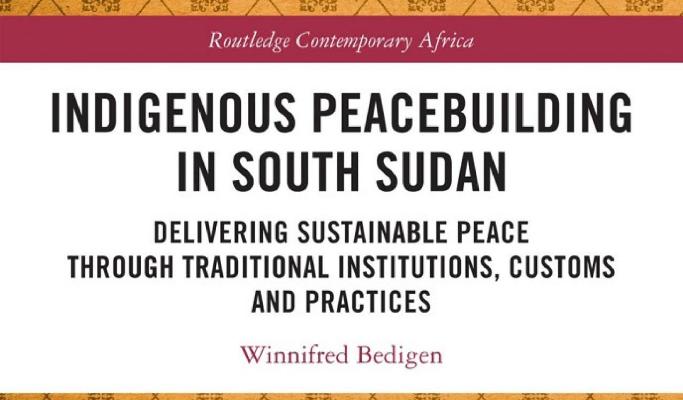Indigenous peacebuilding in South Sudan: Q&A with Dr Winnie Bedigen

Dr Winnie Bedigen is Lecturer in international development at the University of Leeds. We asked her a couple of questions about her recently published book, Indigenous peacebuilding in South Sudan.
Congratulations on your book! Please tell us, how has the book come about?
My previous work considered traditional conflict resolution mechanisms utilised by the Nilotic Lwo of South Sudan in inter-ethnic conflicts and their usefulness in civil war resolution. The analysis showed how such mechanisms can be employed in conflict prevention, peacebuilding and peacemaking. This background provided an understanding of the Nilotic Lwo traditional conflict resolution cultures. More so, it helped narrow the gap between the Westernised concepts of traditional peacebuilding methods that have been applied but failed to deliver sustainable peace in the region. Thus, to deliver sustainable peace, this in-depth study sought to demonstrate that an indigene-centric approach that includes the modernisation of some indigenous practices to suit contemporary inter-ethnic and civil war contexts should be applied, including subtle norms; the role of youth, women and elders; and the concepts of resilience, proximity and social capital in peacebuilding. The book demonstrates that indigenous peacebuilding methods are an antidote to Westernised ideas that are limited in local/regional contexts.
What is the key argument that your book develops?
The key arguments pursued in this book revolve around four areas. First, conflicts are part of human nature, and those parties involved should be at the core of peacebuilding. Second, any resolution should holistically be indigene-centric. That is, it should include the indigenous people, institutions, customs and practices. Third, where ethnic conflicts influence national instabilities, a resolution should initially focus on the ethnic factors, then workable elements are modified to suit peacebuilding at national levels. Fourth, it is recognised that South Sudan has experienced protracted conflicts, and due to the overwhelming humanitarian crises that overflow to the neighbourhoods, external agencies and institutions can work with or should be led by local institutions to build peace.
What innovative or critical contribution does the book make to African Studies?
This book conceptualises indigenous peacebuilding situations in communities emerging from inter-ethnic conflicts and civil wars. It does so by identifying and analysing the ‘indigene-centric’ or the core set of indigenous institutions, customs and practices underpinning the historical and foundational peace values existent in the Nilotic Lwo ethnic cultures and the South Sudan justice system. The core argument is that indigenous peacebuilding is mainly responsible for ethnic co-existence and sustainable peace, and its concepts are apply to civil war situations and at national levels.
There are many critical contributions this book makes. First, it suggests that peacebuilding in post-conflict environments should be indigene-centred at local and national levels. Second, by utilising the qualitative narrative method, this book provides a close link forged between theory, method and data—contributing to ethnographic and anthropological decolonial methodologies. It argues this particular method is crucial in researching indigenous communities. Third, by exploring intra- and inter-ethnic conflicts, civil wars and subtle peacebuilding norms, this book successfully integrates the research results into existing bottom-up peacebuilding theories. Thus, it suggests doing so enables sustainable peace in the communities and at national levels. It adds that the sociological contribution of norms, including resilience, proximity and social capital, is clearly shown to contribute to sustainable peace, unlike the politically led measures. Fourth, the indigene-centric focus redirects empirical research in peacebuilding to commence from the local/community level or the disputants’ cultures/beliefs/ practices. Overall, this book suggests that new peacebuilding initiatives should not seek to ‘westernise’ indigenous peacebuilding by excluding indigenous key attributes.
Give us one quote from the book that you believe will make us go and read it?
For sustainable peace to happen, indigenous peacebuilding should be applied. Indigenous peacebuilding, a peculiar type of peacebuilding—often characterised by a plethora of political, social and economic activities guided by indigenous non-violent norms or processes, must holistically include: First, the involvement of all community members in storytelling, mediation and negotiation. Second, compensation, forgiveness, and offering amnesty to perpetrators (war criminals). Third, rehabilitation of perpetrators, victims and whole communities through cleansing rituals. Fourth, disarmament processes mainly characterised by the physical burning/destruction of weapons of war. Fifth, inter-communal socialising events such as sports (hunting, fishing, wrestling, dancing), digging, harvesting, inter-marriages and child naming socialising ceremonies aimed at maintaining peace and preventing future violence. (p. 1-2)
